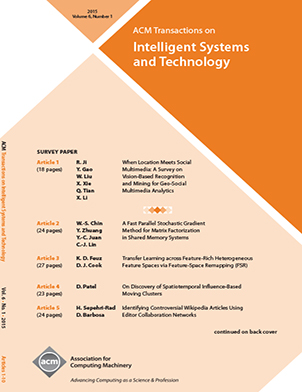Quantifying Levels of Influence and Causal Responsibility in Dynamic Decision Making Events
IF 6.6
4区 计算机科学
Q1 COMPUTER SCIENCE, ARTIFICIAL INTELLIGENCE
引用次数: 0
Abstract
Intelligent systems support human operators’ decision-making processes, many of which are dynamic and involve temporal changes in the decision-related parameters. As we increasingly depend on automation, it becomes imperative to understand and quantify its influence on the operator’s decisions and to evaluate its implications for the human’s causal responsibility for outcomes. Past studies proposed a model for human responsibility in static decision-making processes involving intelligent systems. We present a model for dynamic, non-stationary decision-making events based on the concept of causation strength. We apply it to a test case of a dynamic binary categorization decision. The results show that for automation to influence humans significantly, it must have high detection sensitivity. However, this condition is insufficient since it is unlikely that automation, irrespective of its sensitivity, will sway humans with high detection sensitivity away from their original position. Specific combinations of automation and human detection sensitivities are required for automation to have a major influence. Moreover, the automation influence and the human causal responsibility that can be derived from it are sensitive to possible changes in the human’s detection capabilities due to fatigue or other factors, creating a ”Responsibility Cliff.” This should be considered during system design and when policies and regulations are defined. This model constitutes a basis for further analyses of complex events in which human and automation sensitivity levels change over time and for evaluating human involvement in such events.动态决策事件中影响和因果责任的量化水平
智能系统支持人类操作员的决策过程,其中许多是动态的,涉及决策相关参数的时间变化。随着我们越来越依赖自动化,理解和量化其对操作员决策的影响以及评估其对结果的人类因果责任的含义变得势在必行。过去的研究提出了一个涉及智能系统的静态决策过程中人类责任的模型。我们提出了一个基于因果关系强度概念的动态非平稳决策事件模型。我们将其应用于一个动态二元分类决策的测试用例。结果表明,要使自动化对人类产生显著影响,必须具有很高的检测灵敏度。然而,这个条件是不够的,因为自动化,不管它的灵敏度如何,不太可能使具有高检测灵敏度的人离开他们原来的位置。自动化和人类检测灵敏度的特定组合需要自动化产生重大影响。此外,自动化的影响和由此产生的人类因果责任对由于疲劳或其他因素导致的人类检测能力的可能变化非常敏感,从而形成了“责任悬崖”。在系统设计期间以及在定义政策和法规时,应该考虑到这一点。该模型为进一步分析人类和自动化敏感性水平随时间变化的复杂事件以及评估人类参与此类事件奠定了基础。
本文章由计算机程序翻译,如有差异,请以英文原文为准。
求助全文
约1分钟内获得全文
求助全文
来源期刊

ACM Transactions on Intelligent Systems and Technology
COMPUTER SCIENCE, ARTIFICIAL INTELLIGENCE-COMPUTER SCIENCE, INFORMATION SYSTEMS
CiteScore
9.30
自引率
2.00%
发文量
131
期刊介绍:
ACM Transactions on Intelligent Systems and Technology is a scholarly journal that publishes the highest quality papers on intelligent systems, applicable algorithms and technology with a multi-disciplinary perspective. An intelligent system is one that uses artificial intelligence (AI) techniques to offer important services (e.g., as a component of a larger system) to allow integrated systems to perceive, reason, learn, and act intelligently in the real world.
ACM TIST is published quarterly (six issues a year). Each issue has 8-11 regular papers, with around 20 published journal pages or 10,000 words per paper. Additional references, proofs, graphs or detailed experiment results can be submitted as a separate appendix, while excessively lengthy papers will be rejected automatically. Authors can include online-only appendices for additional content of their published papers and are encouraged to share their code and/or data with other readers.
 求助内容:
求助内容: 应助结果提醒方式:
应助结果提醒方式:


